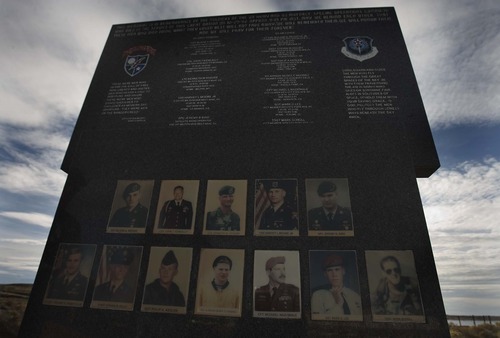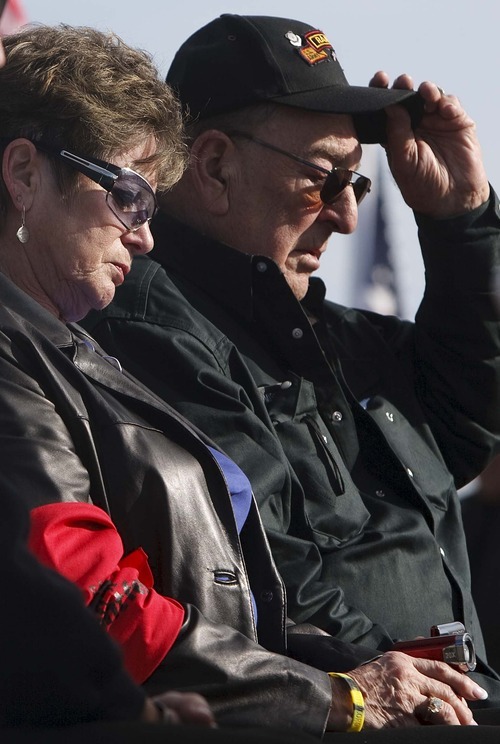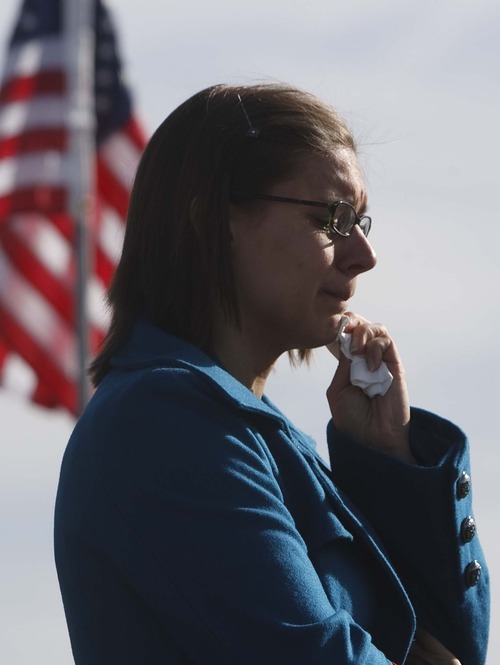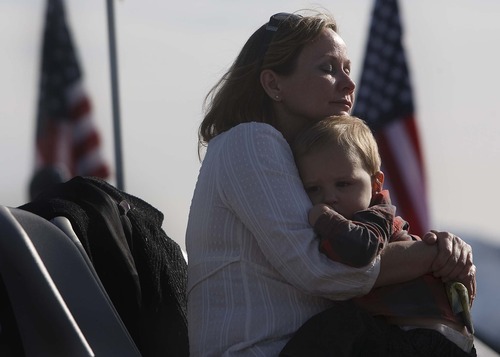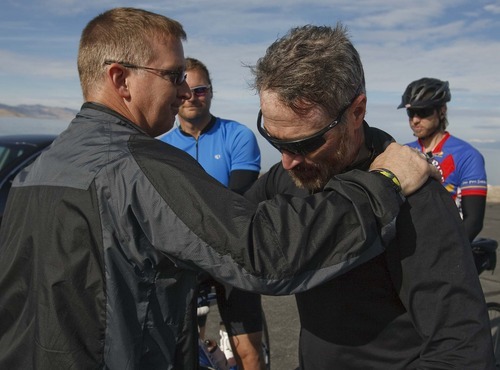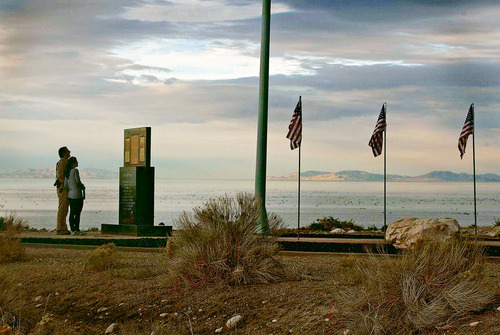Leah Hogsten | The Salt Lake Tribune
The memorial to 12 Army Rangers and Air Force special operations troops that perished in a
Leah Hogsten | The Salt Lake Tribune
Mary-Jane Hughes of Ft. Walton Beach, FL talks with Sylvia Peixotto (right) after the memor
Leah Hogsten | The Salt Lake Tribune
The memorial to 12 Army Rangers and Air Force special operations troops that perished in a
Leah Hogsten | The Salt Lake Tribune
Frank Mishak and his wife Marlys from Clear Lake, Iowa honored the memory of their son Sgt.
Leah Hogsten | The Salt Lake Tribune
Katie Scholl, 27, was just shy of her 7th birthday when her father Mark Scholl perished in
Leah Hogsten | The Salt Lake Tribune
Mary-Jane Hughes of Ft. Walton Beach, FL hugs her grandson Noah DeKorver as she pays tribut
Leah Hogsten | The Salt Lake Tribune
Karl Monger, (left) another former Ranger, was in the air above the Great Salt Lake that ni
Leah Hogsten | The Salt Lake Tribune
Saturday, October 26, 2012 was the culmination of a 775-mile bike ride by a former Ranger m
Leah Hogsten | The Salt Lake Tribune
Jeff Shackleford (center), with his wife Khrystal (left), drove from Hill Air Force Base to
Leah Hogsten | The Salt Lake Tribune
The memorial to 12 Army Rangers and Air Force special operations troops that perished in a
Leah Hogsten | The Salt Lake Tribune
The memorial to 12 Army Rangers and Air Force special operations troops that perished in a helicopter crash just north of Antelope Island twenty years ago on Monday October 29, 1992. On Saturday October 27, 2012, their families, friends and those who helped with the rescue and recovery celebrated their memory with a rededication of a monument on Antelope Island. The crash of the Air Force MH-60G Pave Hawk helicopter, was the last chopper in a four-helicopter formation that was carrying Army and Air Force special operations troops from HAFB to the Army's Dugway Proving Ground as part of a training exercise.
Leah Hogsten | The Salt Lake Tribune
Mary-Jane Hughes of Ft. Walton Beach, FL talks with Sylvia Peixotto (right) after the memorial service Saturday, October 26, 2012. Both women lost their husbands in the crash. Twenty years ago on Monday October 29, 1992, 12 Army Rangers and Air Force special operations troops perished in a helicopter crash just north of Antelope Island. On Saturday, their families, friends and those who helped with the rescue and recovery celebrated their memory with a rededication of a monument on Antelope Island. The crash of the Air Force MH-60G Pave Hawk helicopter, was the last chopper in a four-helicopter formation that was carrying Army and Air Force special operations troops from HAFB to the Army's Dugway Proving Ground as part of a training exercise.
Leah Hogsten | The Salt Lake Tribune
The memorial to 12 Army Rangers and Air Force special operations troops that perished in a helicopter crash just north of Antelope Island twenty years ago on Monday October 29, 1992. On Saturday October 27, 2012, their families, friends and those who helped with the rescue and recovery celebrated their memory with a rededication of a monument on Antelope Island. The crash of the Air Force MH-60G Pave Hawk helicopter, was the last chopper in a four-helicopter formation that was carrying Army and Air Force special operations troops from HAFB to the Army's Dugway Proving Ground as part of a training exercise.
Leah Hogsten | The Salt Lake Tribune
Frank Mishak and his wife Marlys from Clear Lake, Iowa honored the memory of their son Sgt. Blaine A. Mishak Saturday, October 26, 2012. Twenty years ago on Monday October 29, 1992, 12 Army Rangers and Air Force special operations troops perished in a helicopter crash just north of Antelope Island. On Saturday, their families, friends and those who helped with the rescue and recovery celebrated their memory with a rededication of a monument on Antelope Island. The crash of the Air Force MH-60G Pave Hawk helicopter, was the last chopper in a four-helicopter formation that was carrying Army and Air Force special operations troops from HAFB to the Army's Dugway Proving Ground as part of a training exercise.
Leah Hogsten | The Salt Lake Tribune
Katie Scholl, 27, was just shy of her 7th birthday when her father Mark Scholl perished in a helicopter crash just north of Antelope Island with his fellow Army Rangers and Air Force special operations troops October 29, 1992. On Saturday, their families, friends and those who helped with the rescue and recovery celebrated their memory with a rededication of a monument on Antelope Island. The crash of the Air Force MH-60G Pave Hawk helicopter, was the last chopper in a four-helicopter formation that was carrying Army and Air Force special operations troops from HAFB to the Army's Dugway Proving Ground as part of a training exercise.
Leah Hogsten | The Salt Lake Tribune
Mary-Jane Hughes of Ft. Walton Beach, FL hugs her grandson Noah DeKorver as she pays tribute to her husband Sr. Airman Derek Hughes Saturday, October 26, 2012 who lost his life in the crash. Twenty years ago on Monday October 29, 1992, 12 Army Rangers and Air Force special operations troops perished in a helicopter crash just north of Antelope Island. On Saturday, their families, friends and those who helped with the rescue and recovery celebrated their memory with a rededication of a monument on Antelope Island. The crash of the Air Force MH-60G Pave Hawk helicopter, was the last chopper in a four-helicopter formation that was carrying Army and Air Force special operations troops from HAFB to the Army's Dugway Proving Ground as part of a training exercise.
Leah Hogsten | The Salt Lake Tribune
Karl Monger, (left) another former Ranger, was in the air above the Great Salt Lake that night, listening to the crash and recovery operations on tactical radio hugs Danny Cox, (right) Saturday, October 26, 2012 who was at Hill Air Force Base the night of the crash, awaiting the next phase of a training mission. Twenty years ago on Monday October 29, 1992, 12 Army Rangers and Air Force special operations troops perished in a helicopter crash just north of Antelope Island. On Saturday, their families, friends and those who helped with the rescue and recovery celebrated their memory with a rededication of a monument on Antelope Island. The crash of the Air Force MH-60G Pave Hawk helicopter, was the last chopper in a four-helicopter formation that was carrying Army and Air Force special operations troops from HAFB to the Army's Dugway Proving Ground as part of a training exercise.
Leah Hogsten | The Salt Lake Tribune
Saturday, October 26, 2012 was the culmination of a 775-mile bike ride by a former Ranger medic, Danny Cox, (far right) who was back in a hangar at Hill Air Force Base the night of the crash, awaiting the next phase of a training mission. Twenty years ago on Monday October 29, 1992, 12 Army Rangers and Air Force special operations troops perished in a helicopter crash just north of Antelope Island. On Saturday, their families, friends and those who helped with the rescue and recovery celebrated their memory with a rededication of a monument on Antelope Island. The crash of the Air Force MH-60G Pave Hawk helicopter, was the last chopper in a four-helicopter formation that was carrying Army and Air Force special operations troops from HAFB to the Army's Dugway Proving Ground as part of a training exercise.
Leah Hogsten | The Salt Lake Tribune
Jeff Shackleford (center), with his wife Khrystal (left), drove from Hill Air Force Base to help recover bodies of his fellow servicemen the night of the crash, October 29, 1992. Shackleford was friends with Mark Scholl, the father of Katie Scholl, 27, (right) who was just shy of her 7th birthday when her father died. The three have become good friends over the years. Twenty years ago on Monday October 29, 1992, 12 Army Rangers and Air Force special operations troops perished in a helicopter crash just north of Antelope Island. On Saturday, their families, friends and those who helped with the rescue and recovery celebrated their memory with a rededication of a monument on Antelope Island. The crash of the Air Force MH-60G Pave Hawk helicopter, was the last chopper in a four-helicopter formation that was carrying Army and Air Force special operations troops from HAFB to the Army's Dugway Proving Ground as part of a training exercise.
Leah Hogsten | The Salt Lake Tribune
The memorial to 12 Army Rangers and Air Force special operations troops that perished in a helicopter crash just north of Antelope Island twenty years ago on Monday October 29, 1992. On Saturday October 27, 2012, their families, friends and those who helped with the rescue and recovery celebrated their memory with a rededication of a monument on Antelope Island. The crash of the Air Force MH-60G Pave Hawk helicopter, was the last chopper in a four-helicopter formation that was carrying Army and Air Force special operations troops from HAFB to the Army's Dugway Proving Ground as part of a training exercise.




